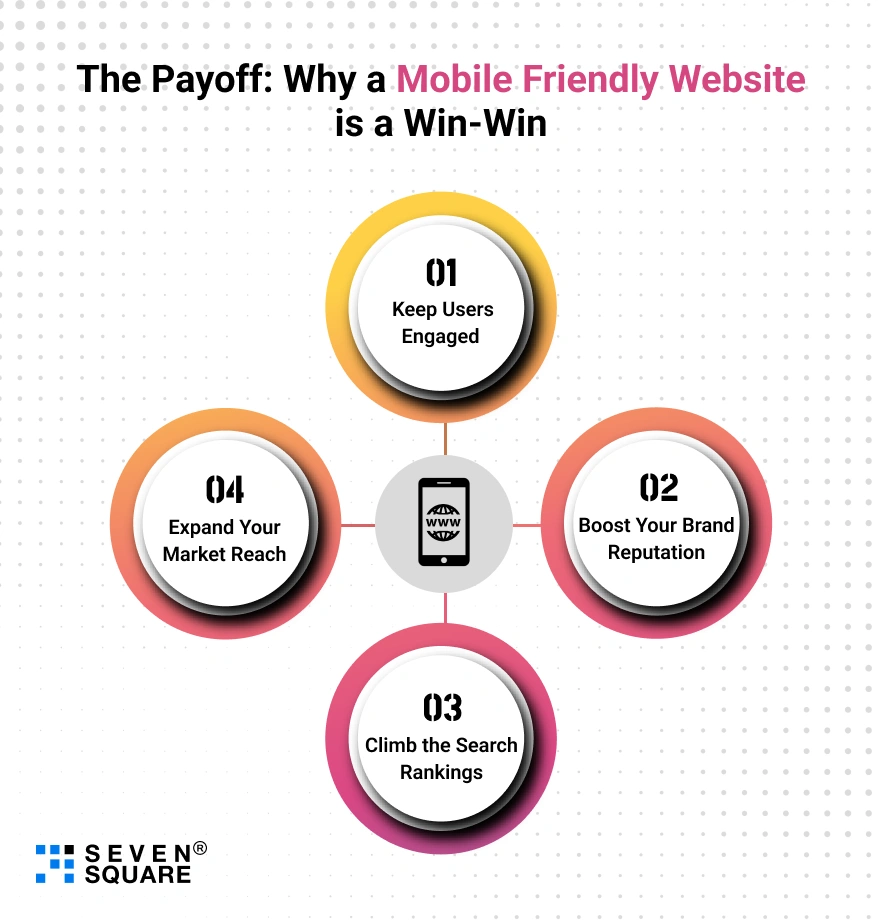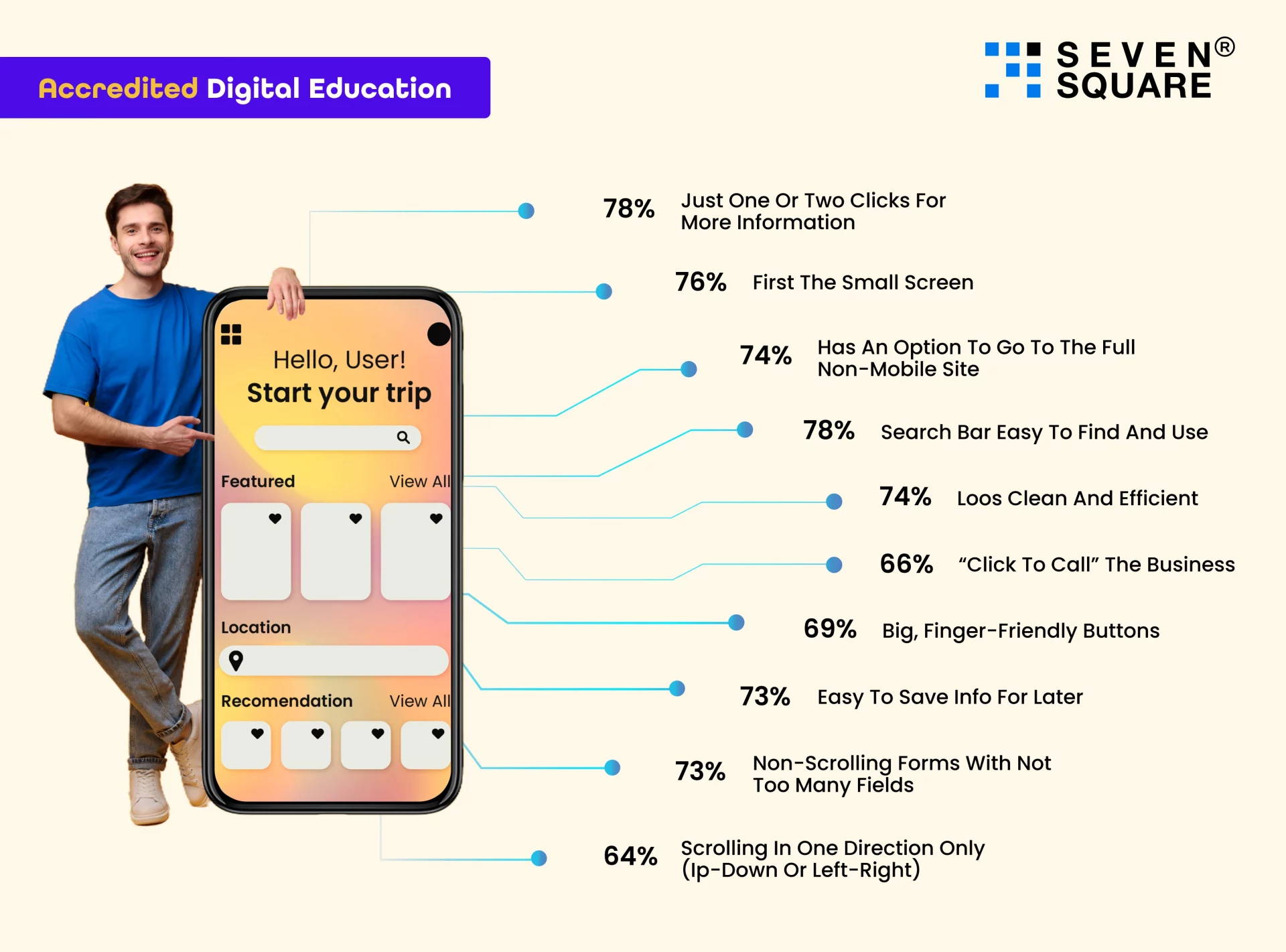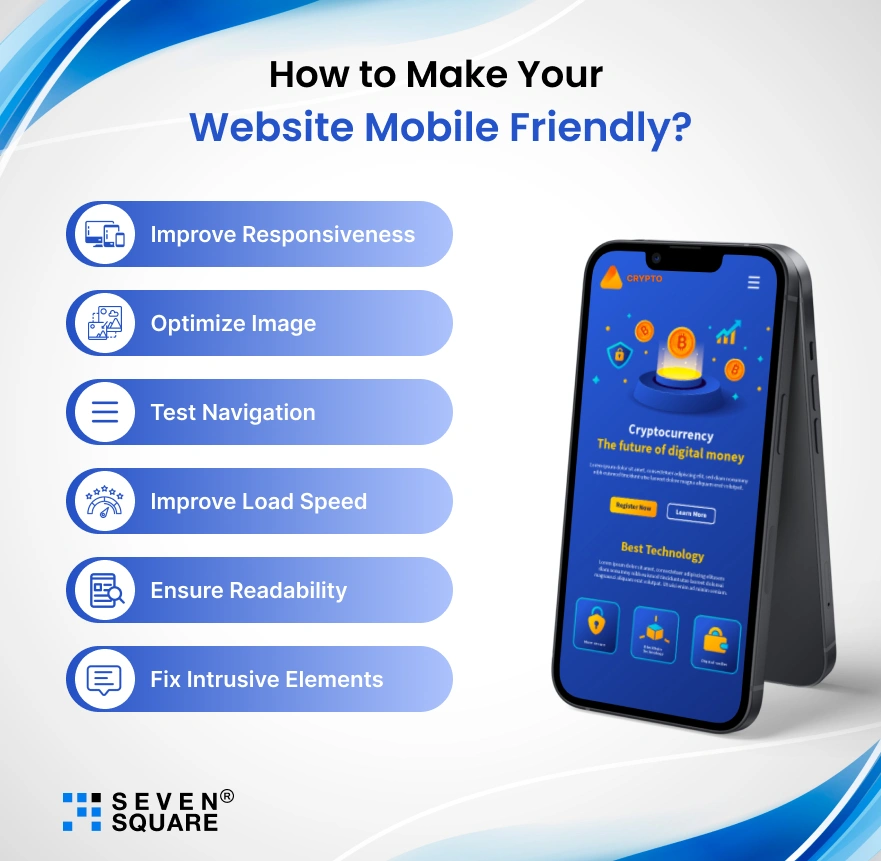People spend most of their time on mobile, and almost 63.38% of website traffic comes from mobile
devices.
That’s why today having a website is not enough because the majority of businesses have it.
You need a mobile-friendly website to connect with users more easily. Google has even made it clear:
no mobile-friendly site, no spot in their search results!
If your site isn’t mobile-friendly, you’re missing traffic and sales.
Don’t worry—our blog explains why it matters and how it benefits your business.
Before diving in, let’s first understand the terms “mobile-friendly” and “mobile-ready” to clear up any confusion.
Mobile-Friendly, Not Just Mobile-Ready: What’s the Difference?
| Feature | Mobile-Ready Website | Mobile Friendly Website |
| User Experience | The website works on mobile but may not be optimized for ease of use. | Website fully optimized for smooth navigation and readability on mobile devices. |
| Design Adaptability | Often just shrinks the content to fit smaller screens. | Automatically adjusts layout, images, and content to fit any screen size. |
| Loading Speed | May have slower load times due to unoptimized elements for mobile. | Fast loading times with optimized images and content for mobile. |
| Navigation | Small buttons or links that may require zooming or precision tapping. | Touch-friendly buttons, large text, and easy-to-use navigation on smaller screens. |
| SEO Impact | Websites may not rank well on search engines because of poor mobile performance. | Higher ranking potential on search engines, as Google prioritizes mobile-friendly websites. |
What You’re Risking Without a Mobile-Friendly Website Design?
1. Frustrated Users:
- Mobile users expect fast, smooth experiences. A website that’s not optimized can result in slow load times, poor navigation, and difficulty reading content.
- Visitors frustrated with a poor mobile experience are more likely to leave your website and it increases bounce rates.
- Unresponsive design means higher user frustration which damages customer trust and loyalty.
2. Lower Search Rankings:
- Google prioritizes mobile-friendly websites through its “mobile-first indexing,” meaning non-optimized sites rank lower.
- A website that doesn’t have mobile friendly design could lose visibility in search results which limits organic traffic and overall reach.
- Poor rankings mean fewer visitors and it means that your competitors with mobile optimized websites will get the traffic and potential sales that you want.
3. Lost Sales:
- Mobile users are more likely to not buy anything if the website isn’t optimized for mobile. Complicated forms, difficult checkout processes, and unreadable text lead to cart abandonment.
- Studies show that 40% of mobile users will switch to a competitor’s website if they have to face a poor mobile experience which means your business just lost opportunities and sales.
The Payoff: Why a Mobile Friendly Website is a Win-Win

Making a website mobile friendly isn’t just about keeping up with trends but it’s a game-changer for your business. Here’s why mobile friendly web design is a win for both you and your customers:
1. Keep Users Engaged:
- A mobile friendly website design ensures smooth navigation that reduces frustration among users and minimizes bounce rates.
- Visitors can easily click through, explore your content, and complete transactions with minimal effort.
- A website that is mobile friendly motivates users for longer visits with better engagements means higher conversions.
2. Boost Your Brand Reputation:
- A clean & responsive mobile website design offers a professional and modern look that is up to customer expectations.
- Providing a mobile-optimized experience shows that you care about your customers’ needs and comfort.
- By making a web page mobile friendly you can build credibility and position your brand as trustworthy and customer-focused.
3. Climb the Search Rankings:
- Google’s mobile-first indexing means that mobile-friendly websites are given priority in search engine rankings.
- Mobile optimization can improve visibility and help you rank higher to have more organic traffic to your website.
- Higher search rankings lead to increased website visits, more leads, and improved conversion potential.
4. Expand Your Market Reach:
- With more than 60% of web traffic coming from mobile devices, optimizing for mobile expands your reach to a wider audience.
- Mobile friendly websites allow you to reach a global audience especially when the customers are on the go, commuting, or accessing content from various locations.
- By staying accessible on mobile, you remain connected to customers wherever they are, making your business more accessible and inclusive.
Going Mobile-Friendly: Practical Steps to Save Your Business from ‘Pinch and Zoom’

We know how crucial mobile-friendly websites are to meet user expectations. Here’s how we ensure every site we build excels on mobile devices:
1. Responsive Layouts: Ensuring Consistency Across Devices
- We use responsive layouts that adapt automatically to any screen size and give users a smooth experience whether on mobile, tablet, or desktop.
- By using flexible grid systems and scalable images, our mobile friendly web designs adjust to different devices quickly while maintaining their readability and usability.
- We include CSS media queries to adapt content and layout for each device while ensuring no zooming or scrolling is needed to view information.
2. Lightning-Fast Load Speeds: Optimizing for Speed
- Speed is crucial and that’s why we prioritize optimizing load times by compressing images, reducing file sizes, and minimizing server requests.
- Our development team applies caching strategies and simplifies code to reduce unnecessary elements which helps create a mobile friendly website that loads faster on mobile networks.
- To ensure peak performance we use tools like Google PageSpeed Insights. We continuously test websites and optimize them until they meet our high-speed standards for mobile responsiveness.
3. Thumb-Friendly Design: Creating a User-Friendly Touch Experience
- We design larger touch icons for buttons, links, and forms because we understand the importance of thumb-friendly navigation so that users can tap without accidental clicks.
- We set interactive elements with spacing in mind while ensuring they’re easy to locate and interact with on smaller screens.
- To improve the user journey, we simplify navigation using intuitive layouts like sticky menus and collapsible sections, allowing for easy scrolling and navigation.
4. Quick Mobile-Friendly Tests: Verifying Mobile Performance
- After development, we run each website through Google’s Mobile-Friendly Test to confirm it satisfies important mobile usability standards.
- Our team regularly tests and fine-tunes the website’s mobile performance on real devices to guarantee a flawless experience for end users.
Success Stories: How a Mobile-Friendly Website Transformed Top Businesses
Let’s see some well-known brands that improved their online presence by making their websites mobile friendly and saw impressive results in the process:
1. Booking.com: Creating a Smooth Mobile Booking Experience
- Challenge: With an increasing number of travelers searching for accommodations on mobile, Booking.com needed a mobile-friendly website to offer the best experience for users on smaller screens.
- Solution: Booking.com optimized its website to be fully responsive, making it easy for users to browse, filter, and book accommodations from any mobile device. They also simplified the mobile booking process to confirm a reservation.
- Results: Since improving its mobile friendly web design, more than 60% of total bookings now come from mobile. The user-friendly interfaces have helped to establish Booking.com as a leader in mobile-friendly travel booking.
2. The New York Times: News for On-the-Go Readers
- Challenge: As more readers turned to mobile for quick news updates, The New York Times needed a mobile optimized website that allowed users to access content comfortably from any device.
- Solution: The New York Times redesigned its website to be mobile-friendly with a responsive layout, improved load speeds, and a simplified, easy-to-navigate mobile interface. They also optimized content for readability on mobile screens for readers on the go.
- Results: The New York Times saw a significant rise in mobile subscriptions & now mobile is driving the majority of traffic to the site.
3. Pinterest: Optimizing Visual Discovery for Mobile Users
- Challenge: As a platform mainly used for browsing images and saving ideas, Pinterest needed a mobile friendly website that would provide a smooth, engaging experience for users on various devices.
- Solution: Pinterest invested in a responsive, mobile optimized website while focusing on quick load times, easy-to-tap images, and “pin” options to make saving and organizing ideas on mobile effortless.
- Results: Today, over 80% of Pinterest’s traffic comes from mobile devices, with mobile users spending more time on the site and pinning more frequently than desktop users.
How to Make Your Website Mobile Friendly?

- Improve Responsiveness: If your website isn’t adjusting well to different screen sizes then you need to implement a responsive design or make your existing design more flexible.
- Optimize Images: Compress large images and ensure they are loading correctly on mobile to speed up your website’s performance.
- Test Navigation: Ensure your menus and buttons are touch-friendly. You can think about switching to a mobile-friendly navigation menu like a hamburger menu for easier access on smaller screens.
- Improve Load Speed: Use tools like Google PageSpeed Insights to analyze your website’s load times and follow recommendations for improvement like removing extra code and reducing server requests.
- Ensure Readability: Adjust font sizes, line spacing, and margins to make your content easy to read without zooming. Use larger text and ensure sufficient contrast between background and text.
- Fix Intrusive Elements: Review pop-ups or intrusive ads that might disrupt mobile users. Use mobile-friendly pop-ups or reduce their use altogether.
FAQs
- If your website isn’t optimized for mobile then you are losing a large number of visitors and customers.
- It is important to have a mobile-friendly website to ensure that visitors can easily browse, shop, or interact with your site on the go for higher conversion rates, and better customer experience.
- You can easily check if your website is mobile-friendly by using Google’s Mobile-Friendly Test.
- In that, you just have to enter your website’s URL, and Google will evaluate its mobile performance.
- If you collaborate with us then we also perform detailed tests on your site’s responsiveness, speed, and overall usability to ensure your website meets the highest mobile standards.
- The cost of making a website mobile-friendly depends on the complexity of the website but remember there are long-term benefits than the initial investment.
- A mobile-friendly website can drive significant returns by attracting more visitors, improving conversion rates, and boosting your SEO rankings.
- Yes, a mobile-friendly website improves the overall user experience by making it easy for customers to interact with your business while on the go.
- When users find a site that’s responsive, quick to load, and easy to navigate, they’re more likely to return. Mobile friendly website design helps businesses to build customer loyalty by providing an enjoyable and seamless experience that keeps visitors coming back.
- No, making your website mobile-friendly doesn’t mean you have to make changes to your desktop design.
- By using a responsive design, you can ensure that the website automatically adjusts to fit all screen sizes, from desktops to smartphones.
- Your desktop version will remain intact, and your mobile version will adapt so that you can have a consistent brand identity across all devices.
- Google’s Mobile-Friendly Test: Checks your website’s mobile usability.
- Google PageSpeed Insights: Analyzes your site’s performance on mobile devices and provides suggestions for improvement.
- BrowserStack: Allows you to test your site on real devices to ensure it’s working well across various platforms.